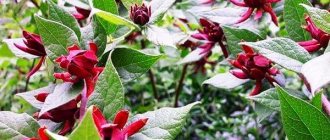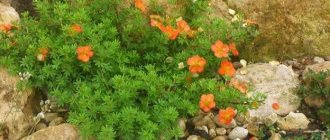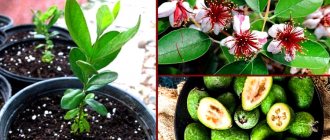The tree pliers feels great in our latitudes. The name of the plant characterizes its aggressive growth. The tree pliers are capable of destroying nearby trees by spiraling counterclockwise around their trunks and climbing to the very top of the crown. With its hooks it not only clings, but also penetrates deeply into the trunk of the “victim”. Without timely help, it is impossible for a tree to get out of such a strong “embrace,” and it dies.
Tree pliers is a very decorative fast-growing vine. Long shoots are woody, sparsely leafy, curly; short - with dense foliage, straight. In growth, the crop rises to a height of up to 12 m. The leaves are alternate, very decorative, turning yellow in autumn. The flowers are collected in panicles, small, bisexual, and have no decorative value. The fruit is an orange spherical tricuspid capsule, ripens by September. All parts of the plant are poisonous.
Types and varieties used
Climbing tree pliers (otherwise climbing, American) is an ornamental fast-growing deciduous shrub that can grow to a height of up to 7 meters. Mature shoots are powerful, leafless, smooth. The leaves are petiolate, pointed at the top and rounded at the base, light green in summer, turn yellow in autumn, then fall off. The flowers are yellow-white, unsightly, and bloom in June for 20-25 days. The fruits are of great decorative value - yellow boxes that ripen by October. In winter, the ripe fruits do not fall off and decorate the leafless vine. A photo of the plant demonstrates its winter beauty.
American Bittersweet variety
The round-leaved tree pliers climb to a height of up to 12 m and are characterized by a lush crown. The stems are creeping and thick. Mature stems are covered with rough, brown, cracking bark. The leaves are ovate, pointed, large (up to 10 cm), glossy, dark green in summer, bright yellow in autumn. The flowers are greenish, collected in corymbs. The fruits are bright orange boxes, when cracked, red arils appear.
Tree pliers round-leaved
Popular varieties used in gardening:
- “Diana” is a decorative form of the female type, bears fruit abundantly and needs a pollinator.
- "Hercules" is a male non-fertile form, used for landscaping.
- Tree pliers (also called whip-shaped) is a decorative vine, up to 10 m high. Mature stems are reddish-brown, newly growing ones are green. The leaves are light green, ovate, slightly serrated along the edge. The flowers are yellowish, collected 1-3 in a corymb. The fruits, from greenish at first to bright orange when ripe, are flattened capsules. Good as a ground cover plant for growing in northern regions.
Wood pliers
Varieties of liana Wood Pliers
There are up to 30 varieties of red bladder. We suggest focusing on the most popular, in demand among flower growers:
Round-leaved tree pliers (Celastrus orbiculatus)
Widely distributed in China and the Far East. The liana reaches quite large sizes, height up to 250 centimeters. The shoots (lateral) are usually densely covered with leaves, the bark is brownish-brown in color.
Tree pliers round-leaved
On young specimens the leaves are a pleasant shade of green. The fruit reaches a diameter of up to 6 millimeters, their color is usually orangish-yellow. The varieties of round-leaved wood pliers “Hercules” and “Diana” are very popular.
Climbing tree pliers (Celastrus scandens)
Its homeland is America, which is why the species is also called “American”. This is a deciduous bush, the height of which is up to 7 meters. The flowers reach a length of up to 0.1 meters. The leaves have an elliptical configuration, the apex is pointed. Flowering duration is up to 20 days.
Tree pliers climbing or climbing
The fruits have the shape of yellow boxes. Cultivated since 1736. Planting and caring for climbing tree pliers does not differ from those procedures required for other varieties.
Whip-shaped or whip-shaped tree pliers (Celastrus flagellaris)
Most common in Asia and the Far East. Photophilous species.
Wood pliers, whip-shaped or whip-shaped
A deciduous representative, the height that the bush can reach is 10 meters. The bark is green, but can also be red-brown. The flowers are pale, yellowish in color. The leaves are green and the fruit is flattened.
Planting wood pliers
Location . The plant grows well both in open areas and in partial shade and shade. It is recommended to plant the plant near high fences or gazebos. In other cases, it is necessary to provide for the construction of a high, strong support.
Attention! Planting tree pliers near fruit trees and other ornamental plants is fraught with their death.
The soil. Wood pliers can grow on any soil. However, it develops better on loose fertile loams and sandy loam soils with a neutral or slightly alkaline reaction. Before planting, it is recommended to add humus to the soil and add leaf soil.
Wood pliers are unpretentious to growing conditions
The seedlings are planted at a distance of about a meter from each other in spring or autumn. The planting hole is dug 60 cm deep and 50 cm in diameter. A drainage layer must be laid at the bottom. The root collar deepens slightly. After planting, the tree trunk circle is mulched.
Advice. Two- to three-year-old seedlings take root much better than annual ones.
Growing and care
Watering. Three times watering is required in the summer months at the rate of 15-20 liters of water for each root. Mature plants are quite drought-resistant. After watering, the soil in the tree trunk zone is deeply loosened.
Trimming. In early spring, before the start of sap flow (in February), sanitary pruning is carried out, removing weak, damaged or frozen shoots. During the growing season, pruning is possible to form a bush or thin out a too thick crown.
Advice. To reduce the aggressive growth of wood pliers, shoots are cut short. Over the course of a year, their growth will again be up to 1 m.
Shelter for the winter. Tree pliers are a frost-resistant plant and do not need shelter. Frozen young shoots quickly grow back in the spring. To prevent freezing of the roots, it is recommended to mulch the tree trunk circle with peat.
The plant must be covered for the winter
Feeding. In spring and summer, dry complex fertilizers are applied once under the wood pliers, which must be embedded into the soil to a depth of 15 cm. Then the soil is shed with plenty of water. In autumn, it is recommended to apply potassium-phosphorus fertilizers in the same way.
Diseases. The plant is not attacked by pests and is resistant to disease.
How to propagate Red Bubblewort
Treeplier or Redbladder easily propagates from seeds. The crop can be sown directly into open soil.
Tree pliers seeds
Even freshly harvested seeds will do; in this case, there is no need for stratification. In rare cases, the crop is sown in the spring; usually this procedure is performed before winter. If you decide to sow plants in the spring, then first carry out stratification by keeping the plants in the refrigerator, air temperature +2...+5°C. Sowing depth is up to 2 centimeters. Gently sprinkle the seed material with fertile soil and lightly water the surface of the ground. You can observe the first shoots from the beginning of June.
Grow seedlings in one place, do not pick for 2 years. In autumn, the height of the vine will reach up to 80 centimeters. The flowering of the culture begins in the 5th year of life.
Cuttings are also practiced. Young shoots (green) take root better than lignified ones. Prepare them in the summer, moisten the lower cut in Kornevin, leave for 16 hours. Planting is carried out in open soil, deepening is carried out in a vertical direction. The top is mulched and watered. Such bushes should be grown in the same place for 2 years. Then, together with the earthen lump, they are transplanted to a permanent location.
Reproduction of wood pliers
Liana propagates in several ways:
- seed;
- root cuttings.
In some cases, propagation by cuttings from green and woody shoots is possible. Green annual shoots are cut in the spring and germinated in damp sand. After 40-45 days they begin to develop roots. Woody shoots are cut into cuttings in the fall. For the winter, containers with cuttings are placed in the basement. Roots will appear only by June. This method of propagation is not productive, since the survival rate of cuttings is very low.
Tree pliers seeds
After autumn harvest, the seeds are dried for about three weeks and immediately sown in open ground. For spring planting, the seeds are stratified for 2 months or kept for a month in containers with wet sand. After these procedures, they are sown in the ground. Shoots appear after a month. In the first year, the plant's growth reaches up to 80-100 cm. Annual vines do not tolerate frost well and require winter shelter. Over the years, the seedlings harden and are no longer afraid of frost. Tree killer blooms from seeds in the 7th year.
For root cuttings, the roots are cut into 7-10 cm pieces and completely deepened into the soil, placing them at an angle. After 30-40 days, the cuttings form a root system. Tree plier bushes produce abundant root growth, which takes root well when transplanted. A plant propagated in this way blooms in the 3rd or 4th year.
The wood plier will curl beautifully around the support
Liana Tree-nose: description of the plant
Celastrus or Wood Plier (another name for Red Bubble) is a genus of crops that belong to the Euonymus family. A perennial representative of the lignified type, its natural habitat is subtropics or tropics. The liana received this name because of its aggressive, even parasitic behavior towards trees.
Red bladderwort in natural conditions
This is a plant that can reach a height of up to 18 meters. During the season, the crop can reach up to 2 meters. The stems are attached to different supports, entwining them beautifully. A wide crown is formed on top. In the absence of supports, the vine begins to creep along the ground.
The leaves of the culture are of the next type, simple, and may have an ovoid configuration. Length – up to 0.05-0.2 meters. The flowers are small in shape and usually have a white, pink, greenish color. They create miniature panicles. The fruit of the crop is red in color; they are eaten by birds, then distributing the seed material along with the droppings. Due to the bright, rich shade of the fruits, the plant often has a “red bubble”.
The green color of the vine turns into a beautiful yellow in autumn, becoming a picturesque corner of the site. The leaves fall in November, when the first frosts have already begun.
The liana begins to bloom at the age of 5. Typically this period falls in June-July and lasts 7 days.
Application in the garden
Wood pliers are used for landscaping arbors, pergolas, and arches. The photo shows how skillfully he copes with this task. Some species look great as ground cover plants, forming a thick green carpet. Climbing tree pliers are planted on the slopes of rivers and reservoirs to decorate and strengthen them.
The climbing tree pliers is the most spectacular representative of the genus and is often grown by gardeners in their gardens. With minimal care, the plant can quickly green up decorative supports and garden buildings.
Round-leaved tree pliers: video
Application of Wood Pliers in garden landscape design
Red Bubble Liana is a wonderful addition to the garden. Its crown will beautifully complement the garden area and hide an unattractive fence. In this case, it will be necessary to vertically direct the crop.
Tree pliers in the garden
The plant is also often planted as a ground cover, which makes it possible to decorate various slopes and the banks of domestic ponds. In a flowerbed, the vine will become an excellent background for plants with colorful blooms.
Redweed is an ideal choice for decorating rocky fences.











